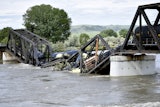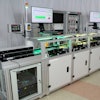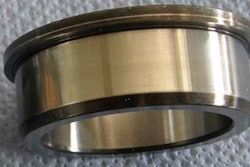I have spent a great deal of my 39-year career focused on optimizing axial fan systems globally. It is interesting that it took most of that time to figure out why some fans windmill backwards and others do not. This article is going to analyze this issue, as well as offer a solution.
A Decades-Long Issue
Years ago (approx.1993) a maintenance person at a chemical facility was injured when he was trying to stop a large axial fan (better known as Fin Fans) from spinning backwards. He was wearing work gloves but he used his hands on the large fan pulley on the outside belt, trying to force the fan to slow down. Somehow his fingers got caught inside the belt, which created an injury. This practice of trying to stop a fan is more common than anyone thinks on industrial sites. It's also not safe to use a piece of wood or a broom handle as a form of a brake. The inertia of these large fans is very high and the guards are usually off at this point, creating an unsafe work area.
This particular injury was not a loss of a finger, but it was serious enough for the reliability engineer to be concerned, and as always, a safety investigation was launched. These fans were driven by V-belts which was more common in this era due to cost and lack of understanding by the industry as to why V-belts are so inefficient for this application. When this injury occurred, the Gates Poly Chain belt was still 10 years away from being invented. The industry did have a timing belt available (at the time) which was called HTD, but the width of the belt that was needed to drive these large fans was still too much in the early 1990s. So V-belts were still the belt drive of choice, due to cost and ease of maintenance.
After this accident, the lead rotating equipment engineer challenged me to solve this issue. The requirements needed by the chemical company were laid out on a local restaurant napkin as we were having lunch. The engineer's requirements for a solution were very simple and straightforward:
- A system that would not allow the fans to windmill backwards, when stopped
- This solution had to be on the fan shaft, in case a drive belt was broken
- The solution had to fit the existing system without a lot of equipment modifications
- The installation had to be easy and it had to fit all the fans at site • No new wires would be needed (eliminating electrical brakes)
At the time, I was not able to source a ready-made solution to fit the plant’s requirements from any known vendor. The Internet was not yet mainstream and Google was not invented until 1998. So I was forced to come up with a solution on my own.
Ahead Of Its Time
At this same time, two other local companies were also having windmilling challenges. This caused me to ponder that this issue was a lot more prevalent than anyone previously thought. After some experimentation, I came up with a device that bolts directly onto the end of the bushing of a fan shaft pulley. It fits any style and size of bushing without any modifications, and can be installed in less than 30 minutes — so the Anti-Rotation Device (ARD) turned out to be a feasible, long-term solution for each plant's application. The three original companies did install a lot of ARDs and some of the original units are still running now, decades later. Many other companies, however, decided to stick with shorter-term V-belts, which for axial fans were not so efficient.
Fast forward to the turn of the century. The industry is now being forced to become more efficient for these larger cooling fans. V-belts are now a thing of the past for belt driven axial fans. The new timing belt technology is actually cheaper, with less shaft weight. So even the OEMs would never design a V-belt.
V-belt Slippage
V-belt slippage, which causes airflow loss, results in cooling losses to the facility. The fact that V-belts slip actually covered up the need for ARDs until the past couple of decades. The industry recognizes a V-belt to be approximately 93 percent efficient, but this is much lower on large axial fans due to the short center distance and high ratio between the driver and driven pulleys. The belt wrap on the small pulley is such that the belt drives slip much more than 5 percent, whereas a timing belt is 98 percent efficient and can’t slip or create a loss in cooling. It is still surprising to me how many older facilities still run V-belts on the axial fans. One has to also keep in mind that these larger fans sit way up high above the pipe racks so maintenance is often neglected on them. “Out of sight, out of mind.”
Additional Best Practices
Belt drives are just one small part of optimizing air coolers. Other optimization efforts are as follows:
- Use high-efficiency fans
- Clean the fin tubes properly and yearly
- Block all the holes and gaps in the fan box
- Run the fan blade on the fan curve as opposed to in a stalled condition
- Add inlet bells
- Fix tip clearance issues
- Install seal discs on hub
Creating a more efficient cooling system is very involved — with a lot of engineering and experience required. Most end users do not have the necessary skills in-house, so often they rely on the cooler OEMs. Cooler OEMs are not in a strong position to optimize existing air coolers. They are in a good position to sell new air coolers. They usually want to supply new bays or supply new coolers with larger motors. Often, you can optimize the existing air coolers if you have the right skills, or by engaging a practiced specialist.
The one downside to optimizing air coolers is this windmilling effect, which is shown in this YouTube video link.
The most common method of supplying coolers is two fans sharing the same bay, so when one is turned off the other will see a reverse flow up top, causing windmilling. If the shut-off fan is not windmilling it means the system is not properly optimized.
Conclusion
Understanding these few facts is a good first step toward axial fan efficiency:
- Optimized fan systems tend to windmill more
- Non optimized fan systems tend to windmill less
- Windmilling fans create a safety issue for workers
A safe solution for windmilling axial fans is an ARD device bolted onto existing fan pulley bushing, to get maximum efficiency. The best practices listed above will help to boost your efficiency as well, and an assessment from a qualified specialist can provide more information leading towards solutions to positively impact your bottom line.
Nick Agius has been working with axial fans since 1978 and is a Rotating Equipment Specialist for Motion Industries. His Anti-Rotation Device (ARD) solution for Canada and the U.S. was first patented in 1996, followed by two other patents. Visit www.MotionIndustries.com for more information about Anti-Rotation Devices.























